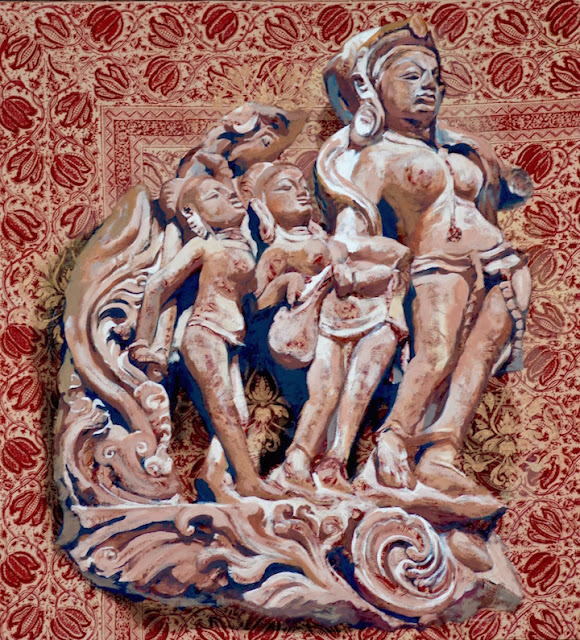This large statue in the Art Institute of Chicago depicts an early form of the goddess Saraswati, the Hindu goddess knowledge, music, and arts.
The pointed Gothic arch shape and simple geometry of the circular areole behind the head and the solid geometric forms of the cylindrical crown and spherical breasts contrasts with the complexity of the intricately carved jewelry.
I select a salmon colored handmade paper from Nepal printed with a metallic gold ink. The reflective quality of the gold is gorgeous in person, but is exceptionally difficult to photograph. The gold looks greenish in contrast to the warm pinkish salmon.
Four-Armed Sarasvati
26” x 20” image
conte and acrylic on paper printed with metallic ink
The metallic ink has a rather slick surface. It is a struggle in the beginning to get the conte crayon to stick, but I like the pattern remains evident. The zigzag pattern gives an almost "tribal" look to the icon. The finished drawing has a strong resemblance to Inca or Aztec art. I'm not exactly sure why, but I believe it is because of color and pattern associations.
A large acrylic painting follows the drawn study. Rather than working with a zigzag pattern background, I am inspired to use a block-printed fabric from India. This fabric panel is authentic, hand made Kalamkari cotton fabric from the Andhra Pradesh state. The word Kalamkari (or Qalamkari) is derived from the Persian words ghalam (pen) and kari (craftsmanship), meaning drawn with a pen.

This Kalamkari drapery panel has a medallion that is smaller than most found on bedspreads or tablecloths. Imperfections of the design are inherent to hand blocked fabric. the slight mistakes happen in the placement of the hand carved wood blocks (registration) as each color is separately printed.

This fabric design incorporates both the geometry of the large circles, organic floral and vine lattice, and paisley shaped forms. Persian influence can be seen in this tradition patterning.

After stapling the fabric on a wooden stretcher frame, I lightly draw a vague contour of the figure in pastel chalk. I've decided to try stenciling another vine and leaf motif design in several places using an iridescent silver acrylic paint. I think this will bring out the cool blue colors in the predominantly warm palette.


I find the patina of age on the sculpture fascinating. An array of rust, brown, and grey colors mingle. By using transparent washes of paint, I am able to allow the pattern of the fabric to show through in parts of the figure. I am happy with the illusion of a shiny surface on the knees.

Working with the fabric design has allowed me to incorporate the pattern in unusual ways. I have placed the very tip of the nose at the center of the concentric circles. It is a coincidence that the edge of the lower lip, necklaces, and a ridge on the crown also follow other circles as they radiate out from the center.

Paisley shapes in the fabric seem to look a lot like the jewelry. Finally, dark washes create the illusion that the sculpture is casting shadows on a backdrop.
Saraswati, Goddess of Learning
48 x 36 inches
acrylic on hand blocked fabric
Goddess Durga Seated on a Lion Throne
48 x 36 inches
acrylic on hand blocked fabric

Goddess Durga
The image above shows Durga seated on a lion throne, though she is often depicted riding a lion.

Goddess Durga
36” x 36”
Manasa is a Hindu goddess of snakes, worshipped mainly in Bengal and other parts of northeastern India mainly for the prevention of snakebites. She is also an important fertility deity. Manasa is ceremonially worshipped on Nag Panchami, a festival of snake worship. Women observe a fast (vrata) and offer milk at snake holes.
Snake Goddess Manasa
48 x 36 inches
acrylic on hand blocked fabric
I use a predominantly red Kalamkari fabric for two paintings depicting Yamuna, the goddess of a river that runs parallel to the Ganges. The terra cotta color artifacts are very similar to the background color of the fabric. It might be a challenge to use a very limited palette of subtle tone on tone.
River Goddess Yamuna with Attendants I
48 x 44 inches
acrylic on hand blocked fabric
The figures stand on swirling forms representing waves in the river water.
River Goddess Yamuna with Attendants II
48 x 44 inches
acrylic on hand blocked fabric
Mother Goddess Brahmani
36 x 48 inches
acrylic on hand blocked fabric
A Lingam is an iconic representation of the Hindu god Shiva, often interpreted as a phallic symbol. The drawing below is based on a Mukhalinga - a lingam with a face (one, four, or five faces).
Five-faced Lingham
26” x 20”
conte and acrylic on paper printed with metallic ink
The five faces represent Shiva's five aspects that compose the entire universe. Though Shiva is a male deity, the goddess Parvati (Shiva's wife) faces north and represents water. The east face is Mahadeva, representing the earth. The west face is Nandi Nandi (Shiva's bull) denoting the wind. Bhairava looks south (fire), and a fifth face looking up is (rarely depicted and not shown here) represents the sky.
Thank you for visiting my blog!
All of my paintings and drawings pictured are for sale. Price available upon request. I am able to supply higher resolution images to interested buyers. If inquiring, please leave a comment with your email address. I will immediately contact you and hide your info from public view.
All of my paintings and drawings pictured are for sale. Price available upon request. I am able to supply higher resolution images to interested buyers. If inquiring, please leave a comment with your email address. I will immediately contact you and hide your info from public view.
Or email me at Cynthia.S.Hayes (at) gmail (dot) com











No comments:
Post a Comment